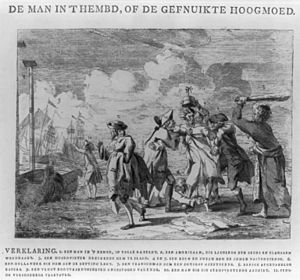First League of Armed Neutrality facts for kids

'The man in the nightshirt, or the smothered hubris
This old picture shows a man in a nightshirt, who stands for England. He is being attacked by people representing other countries. A Swede and a Dane hold him, a Frenchman puts a silly hat on his head, and a Dutchman puts chains on his ankles. An American runs off with his clothes, and a Russian is about to hit him. In the background, you can see merchant ships sailing away.
The first League of Armed Neutrality was a group of European countries that teamed up from 1780 to 1783. They wanted to protect their ships from the British Royal Navy. During the American Revolutionary War, Britain was stopping and searching neutral ships for French goods. This was because Britain was fighting France.
British ships would often stop and search neutral merchant ships. They would take any goods they thought were helping France. These goods were called contraband. This policy caused big problems for countries that were not part of the war. Many ships were captured. For example, by 1778, at least 59 ships from Denmark, Norway, Sweden, and the Netherlands had been taken. This made many countries very upset.
Contents
Why the League Started
Empress Catherine II of Russia started the first League. She announced Russia's policy of armed neutrality on March 11, 1780. This meant Russia would stay neutral in the war. However, they would use their navy to protect their trading ships.
Catherine believed that neutral countries should be able to trade freely by sea. The only exception was weapons and military supplies. She also said that a country could only block a port if its warships were actually there. They could not just declare a whole coast blocked. To make sure her rules were followed, Russia sent its navy to the Mediterranean, Atlantic, and North Seas.
Who Joined the League?
Denmark-Norway and Sweden (which also ruled Finland) agreed with Russia's ideas. They decided to adopt the same rules for their ships. In August 1780, these three countries signed agreements. They formed the League of Armed Neutrality. Their plan was to have their ships travel together in groups called convoys. They would declare that their goods were not contraband. However, Britain did not accept this idea.
Spain, which was fighting Britain, promised to respect the League's neutrality. Britain, however, was not happy about it. The Dutch Republic (the Netherlands) planned to join the League in January 1781. But Britain found out before they could sign the treaty. Britain then declared war on the Netherlands. This happened after Britain captured a Dutch ship carrying what they called contraband. Because of this, the Netherlands could not join the League of neutral countries.
Other countries joined the League later. In 1781, Prussia, Austria, and Portugal became members. In 1782, the Ottoman Empire joined. Finally, in 1783, the Two Sicilies joined too.
What the League Achieved
The League members stayed out of the war. But they threatened to fight back together if any of their ships were searched by a country at war. The British Royal Navy was much larger than all their navies combined. So, as a military group, the League was not very strong. Catherine herself called it an "armed nullity," meaning it didn't have much military power.
However, the League was very important in diplomacy. France and the United States quickly supported the League's idea of free trade for neutral countries. Britain did not agree with this idea. But Britain did not want to make Russia angry. So, Britain generally avoided stopping the League's ships. Even though Britain fought the Netherlands, it did not officially see the League as an enemy. Britain still got many important supplies for its navy from the Baltic Sea, where many League members were located.
How the League Ended
The League of Armed Neutrality stopped being active after the Treaty of Paris (1783). This treaty officially ended the American Revolutionary War.
Later, during the Napoleonic Wars, there was a Second League of Armed Neutrality. However, this second League was not as successful. It ended after Britain won the Battle of Copenhagen (1801).

